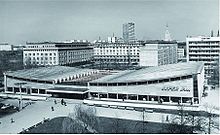Supersam (Warsaw)
The Supersam was a self-service shop and self-service restaurant built in 1962 in the center of Warsaw . When it opened, the Supersam was the first supermarket in a large hall in the People's Republic of Poland . In 2006 it was demolished to make way for a high-rise building. The syllable sam means "self" in Polish and is meant as a short form of samoobsługa , "self-service".
The building was intended to be an experiment for a modern form of state-owned trade in the People's Republic. The then groundbreaking function was housed in an architecturally unusual building that was planned by the architect Jerzy Hryniewiecki in collaboration with Maciej and Ewa Krasiński, Maciej Gintowt and the civil engineers Wacław Zalewski, Stanisław Kuś, Andrzej Żórawski and Józef Sieckowski. The design won a prize at the São Paulo Architecture and Design Biennale .
The Supersam formed the end of Puławska Street, the main road going south. The roof, which weighs more than 100 tons, was designed as a Tensegrity construction, one of the first of its kind in the world. This construction principle resulted in a large, pillarless sales room with a floor area of 1000 square meters. The ceiling was clad from below with fire-impregnated wood.
After more than 40 years of operation, the roof, suspended from steel cables, showed rust damage, according to an expert report ordered in 2004. When the report was made public in early 2006, there was a controversy about demolition or renovation. Instead of replacing the steel cables in order to preserve the building, as suggested by one of the designers at the time, the head of the building supervision claimed that there was an acute risk of collapse and ordered it to be closed immediately. The last day of sale was April 9, 2006. The report served as the justification for the demolition, which began in November 2006 despite violent protests by Warsaw architects. The steel structure was dismantled and was supposed to be rebuilt in another location, but this did not happen. Construction of the Plac Unii high-rise began immediately after the demolition .
literature
- Filip Springer: head births. Architectural reports from the People's Republic of Poland. Dom Publishers, Berlin 2015, pp. 82–89
- T. Przemysław Szafer: Współczesna architektura polska. Warszawa: Wydawnictwo "Arkady" 1988, p. 227, ISBN 83-213-3325-7 .
Web links
- Supersam Plac Unii Lubelskiej Warszawa mrowka PRL. YouTube (TV report for the opening in 1962)
- Pawel Giergoń: Warszawa - Super Sam . sztuka.net, February 20, 2006 (Polish)
Coordinates: 52 ° 12 ′ 46 ″ N , 21 ° 1 ′ 12 ″ E

